Out with the old, in with the new! SPIKE™ Essential by LEGO® Education is a recently launched set of bricks and electronics for kids in primary school education. The new educational robotics kit has arrived, but its welcome is saturated with mixed feelings. In this review, we examine every aspect of SPIKE Essential to understand why.
The old and proven WeDo 2.0 is now out of the picture. The Core Set is retired and the reserves are completely sold out in many countries. Spare parts are still available, for now.
SPIKE Essential is supposed to fill the educational void in early primary school. It is an important part of the official LEGO Learning System, which claims to be “a scalable learning system based on the familiar LEGO® brick”. In practice, this means that the electronics, bricks and even programming are compatible with SPIKE™ Prime – great!
However, SPIKE Essential is not a straightforward replacement for WeDo, it’s something else entirely.
Unlike previous series from LEGO Education, intended mainly for learning robotics and programming, SPIKE is a “cross-curricular STEAM solution”. Is it perhaps a jack of all trades and a master of…? Before we judge it too harshly, let’s take a look at the important features of this kit in the context of school education with focus on robotics and coding.
Pick the aspect that interests you the most.
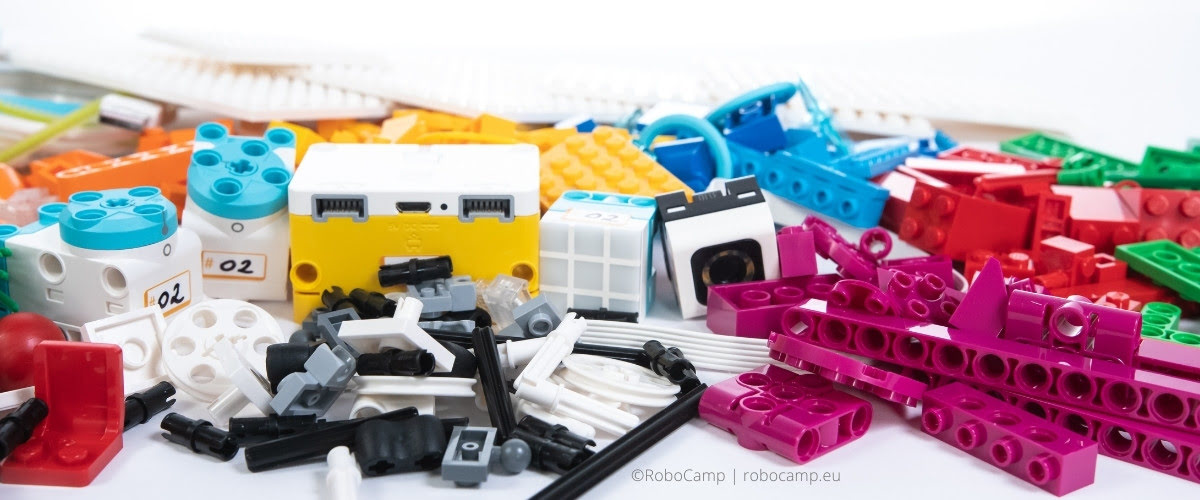
Building¶
First, let’s unpack. Everything comes in a plastic box in size identical to SPIKE Prime. Like all the previous products from LEGO Education, bricks are all neatly packed in a plastic box and sorted, thanks to two color-coded sorting trays.
ProTip: If you want to unpack the kits with students, SPIKE Essential makes it easy. Just put the stickers on and open the brick packets into the tray; bricks come already sorted! Preparing one kit should take around 5 minutes.
In addition to the elements from the list, the box contains spare parts. That’s a big plus! Especially since this kit contains a lot of small elements, which tend to get lost, and rubber bands, ruthlessly tested and stretched by young learners.
Elements of SPIKE Essential are visibly different from the usual selection in LEGO Education products. Not only in terms of colors, or electronics, but also when it comes to individual bricks, or building systems incorporated into one product. They all influence the building process, not always in a positive way. We examine them all: colors, bricks, and electronics.
Colors¶
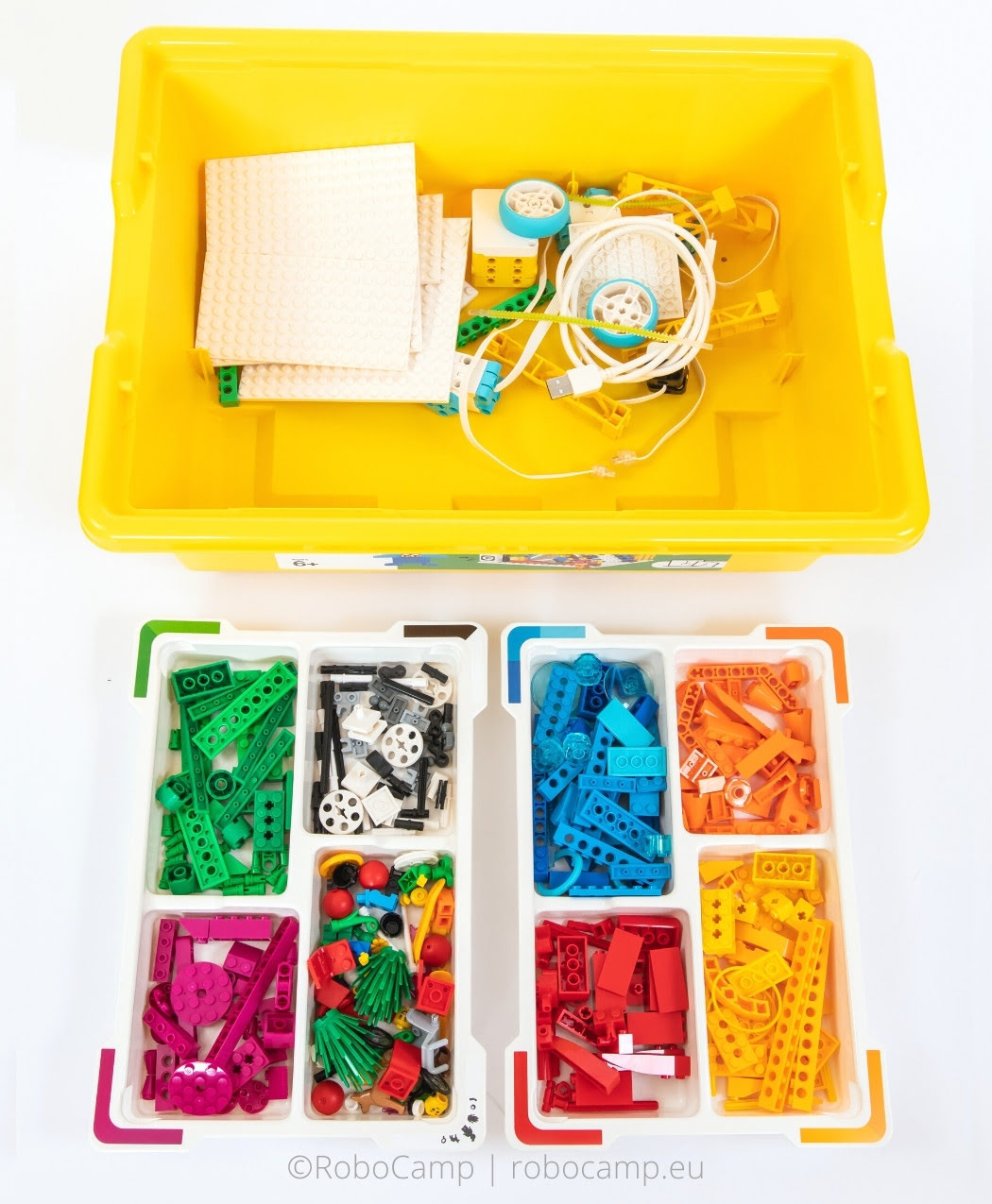
Subjectively, the colors in the new kit are a bit hodgepodge. Of course, when discussing favorite colors, there is no accounting for taste.
Understandable as it is, we simply must talk about the colors in SPIKE Essential, because of… the sorting trays.
Yes, sorting bricks according to their color (yellow, orange, blue, red, green, purple, black&white) is fast. Super fast. If your students sort the bricks themselves at the end of the lesson, you will surely appreciate this feature.
Are there any downsides? Unfortunately, yes. Finding the blue element you want in a crowd of blue takes more time. As a consequence, a purposeful building process (as opposed to creative) may be more bothersome for students. How much? Recall the last time you were looking for your keys. You know where they should be, yet you cannot see them. Well, your students will get familiar with this feeling.
However, this setback may not necessarily be reflected in overall lesson time. Since most lessons for SPIKE™ Essential are short (45 mins), and building robots with this set is real quick, chances are that the sorting system will not impact your lesson plan schedule.
Lessons as usual, if slightly more irksome.
Bricks¶
Bricks – the essence of every LEGO set. SPIKE Essential has 449 colorful bricks in total, four minifigures included.
Minifigures in educational sets are a pretty heated topic that has its proponents (mostly kids) and opponents (mostly teachers). Each side has some good arguments. Playing with minifigures makes it easier for some kids to relate to the project. On the other hand, it can be challenging to convince students to focus on anything else than the minifigure. Nonetheless, they are already in the kit, so let’s make the most of them.
You know what’s not included? GEARS. You won’t find a single gear wheel in SPIKE™ Essential. Even the wisest do not know why, but we suspect that another new set from LEGO, BricQ Motion, may have had something to do with this.
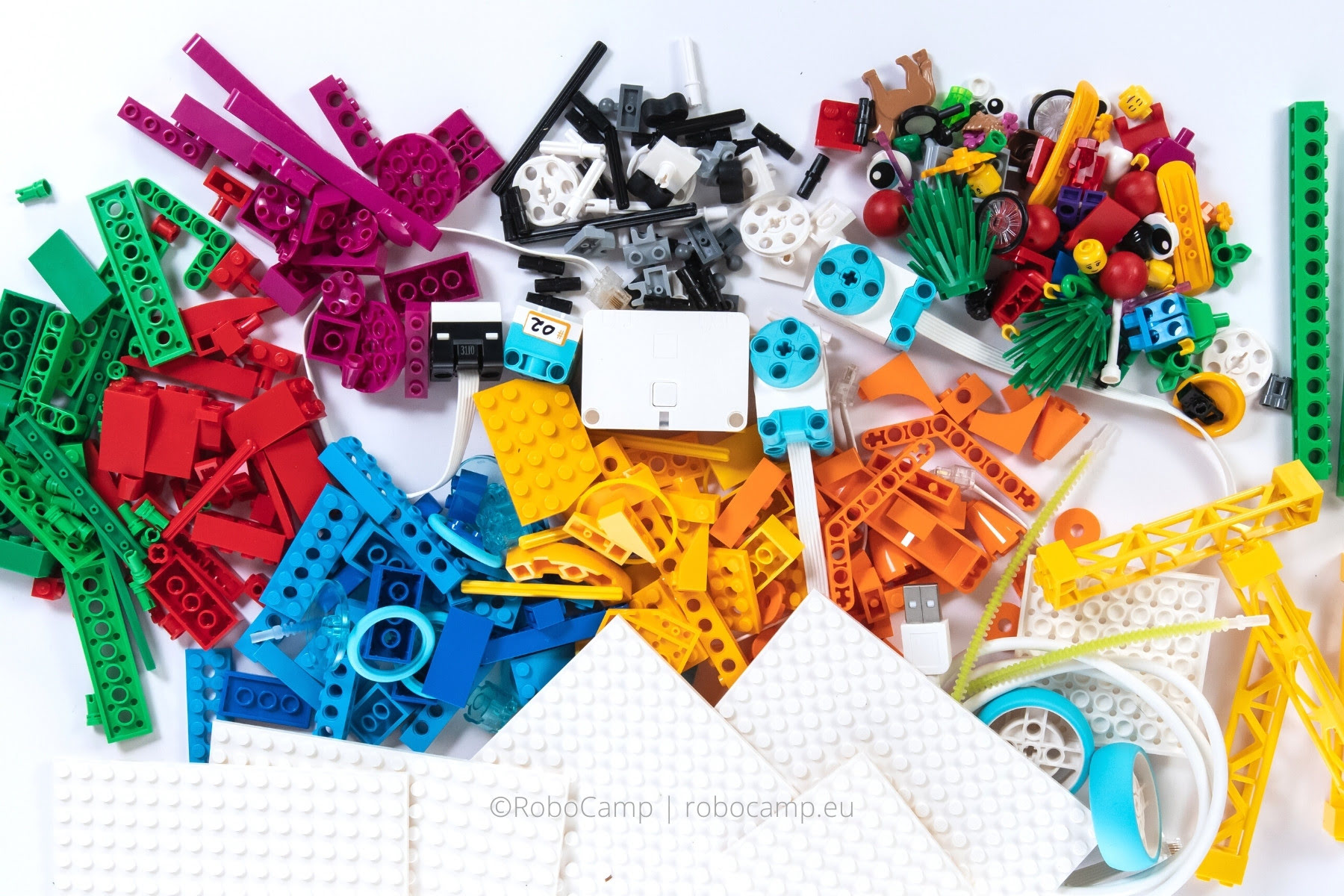
Complete lack of gears is a real problem when building robots, or any mechanisms. With gears, you can transfer the drive from the motor somewhere else, you can create transmissions with various properties and consequently, illustrate real-life STEAM concepts. Without them, the motor can only propel elements connected directly.
Such restrictions also influence the longevity of this set. Since it does not encourage creativity construction-wise, designing new robots is more difficult. With fewer robot designs available, schools may have to purchase additional sets sooner.
Bricks of SPIKE™ Essential combine two building systems: Classic and Technic. They differ significantly, and the Bridge Pin does not solve all problems caused by this unlikely couple.
Before we get to the problem, let’s explain the key difference. In the classic LEGO System, you stack bricks onto each other and they stay connected because of studs. You build your creation from the bottom up, in an almost 2D fashion. Mistakes are easily corrected. LEGO Technic, on the other hand, relies on pins to firmly join elements together. It takes the building process to the next level, because you need to imagine how your entire construction is supposed to look like in 3D before you begin. Essentially, Technic is for more advanced builders.
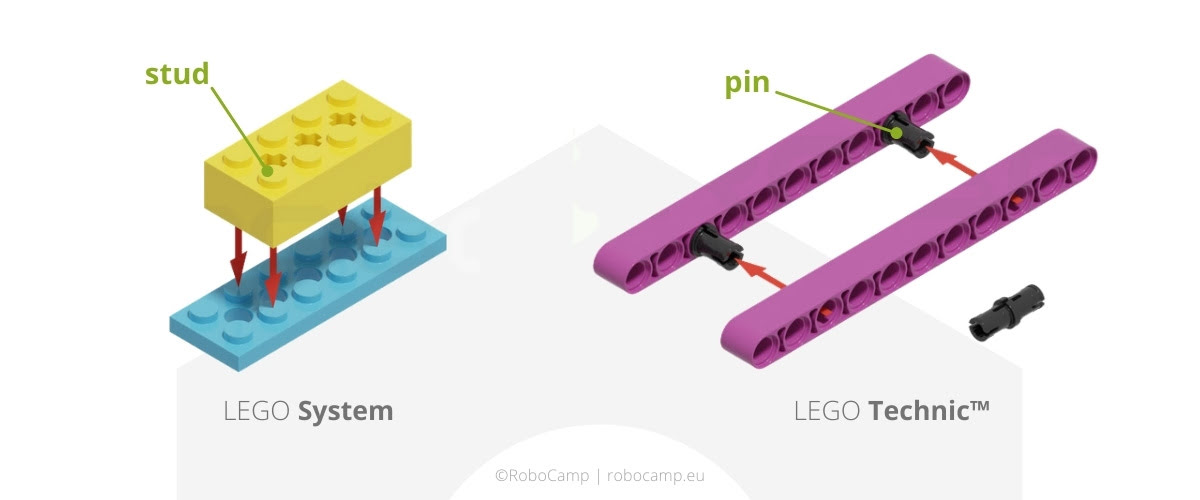
The set contains quite a lot of Technic elements, yet surprisingly, it is recommended for young learners – children ages 6+. Electronics have no studs, which forces kids to use both systems at the same time. Projects with step-by-step instructions are feasible, but what about creative building? Make no mistake, spatial imagination is a difficult skill and takes practice to master. Do not expect six-year-olds to create impressive original projects from these sets, because it’s just too hard.
Despite flaws, the selection of bricks in SPIKE™ Essential offers some advantages.
Many elements speed up the building process. The kit includes plates in several sizes, connectors, bricks with pins, or columns to quickly raise an element up a level. You can create something with fewer elements, which means less time spent building. Saving time is crucial when you have only 45 minutes for a lesson.
Another asset can be found in the most colorful compartment of the box. Unlike older educational kits, SPIKE Essential has a lot of small, purely decorative elements, the purpose of which is to stimulate the imagination of students. This addition may have a positive influence on kids in the long term. Although decorations have little to no influence on constructive imagination, they certainly promote imaginative fantasy and allow children to personalize their builds.
Students won’t have much freedom in creating mechanisms, but they will be able to exercise their imagination on the surface level, to modify robots with non-essential, yet colorful and decorative elements.
Electronics¶
Create engaging, interactive models by connecting the Intelligent Hub, motors, a Light Matrix, and a Color Sensor - to bring STEAM concepts to life.
- slogan from the official LEGO Education website
SPIKE Essential includes 5 electronic components. In addition to the hub with a built-in gyro, a light matrix and a color sensor, you get 2 small angular motors and a rechargeable battery for the hub.
None of the electronic components have studs. Instead of using the classic LEGO method to connect bricks, kids must get acquainted with pins and Technic elements.
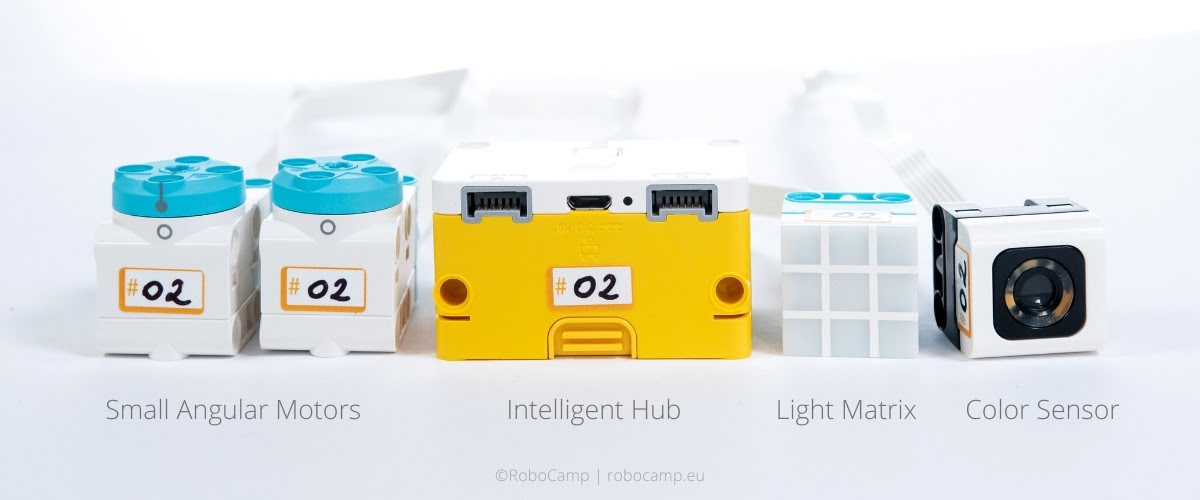
Angular motors are the smallest in the SPIKE series. It's great that they are featured in the set recommended for young students, because the smaller the motor is, the easier kids can incorporate it in their construction. Motors have a built-in rotation sensor, which can become useful when programming in Word Blocks, or Python. More on programming below. Since you get 2 motors in 1 set, you can create vehicles! They cannot be interactive (because the hub has only 2 ports), but they roll.
The color sensor is precise and easy to use. It has two operating modes: detecting 8 pre-programmed colors that match the bricks, or detecting the intensity of reflected light. However, the object must be very close to the sensor, around 1-2 cm.
Light Matrix is a completely new element. It’s an esthetically pleasing simple display, where you can control the color and brightness of individual “pixels”, i.e. LED lights. It’s easy to program and use even in Icon Blocks. Kids will like it, adults will like it, because it’s shiny and seems to encourage creativity, but in truth, it has a limited use. Pity that the light matrix is not interactive, it’s just a display.
The Small Hub of SPIKE Essential is small (good), but limited (bad). It can be connected with a device via Bluetooth or USB cable. You can incorporate it fairly easily into robots, or builds, thanks to its compact size, which is quite unusual for a LEGO hub and deserves to be noted. For comparison, recall the EV3 Brick, or even the Large Hub from SPIKE Prime.
On the other hand, larger counterparts have much more possibilities. The Small Hub featured in SPIKE Essential has two input/output ports, Bluetooth connectivity and a built-in gyro. That’s not much. Few ports mean less interactive constructions, which stands in sharp opposition to the LEGO marketing slogan quoted above.
Nonetheless, the electronics are high quality, intuitive in use and seem sturdy. They work without any problems. Connection with the hub is also very smooth, both via Bluetooth and the USB cable. This high standard is something that we’ve come to expect from LEGO, and they delivered.
Superior quality is of significance to every user, yet it’s even more important when working within a strict time frame, where any unexpected issue can possibly mean a delay and, in consequence, an unfinished project. In this context, electronics of SPIKE Essential should work well for school education.
Programming¶
SPIKE Essential can be programmed in two languages, Icon Blocks and Word Blocks, both available through the LEGO Education SPIKE™ app.
You can use the app on PC, tablets, iPads and more. What’s more, the programming possibilities are the same, no matter which device you use! This is great news for several reasons.
Such flexibility gives teachers more freedom in selecting hardware that works best for their students. Moreover, chances are that schools already have the necessary equipment, so they can avoid additional costs. This improvement in terms of software compatibility also means that LEGO Education listens to their customers and tries to improve their products. Kudos!
Speaking of compatibility, the same app is used for programming SPIKE™ Essential and SPIKE™ Prime. This could be a very useful feature in your lab, provided you use both sets.
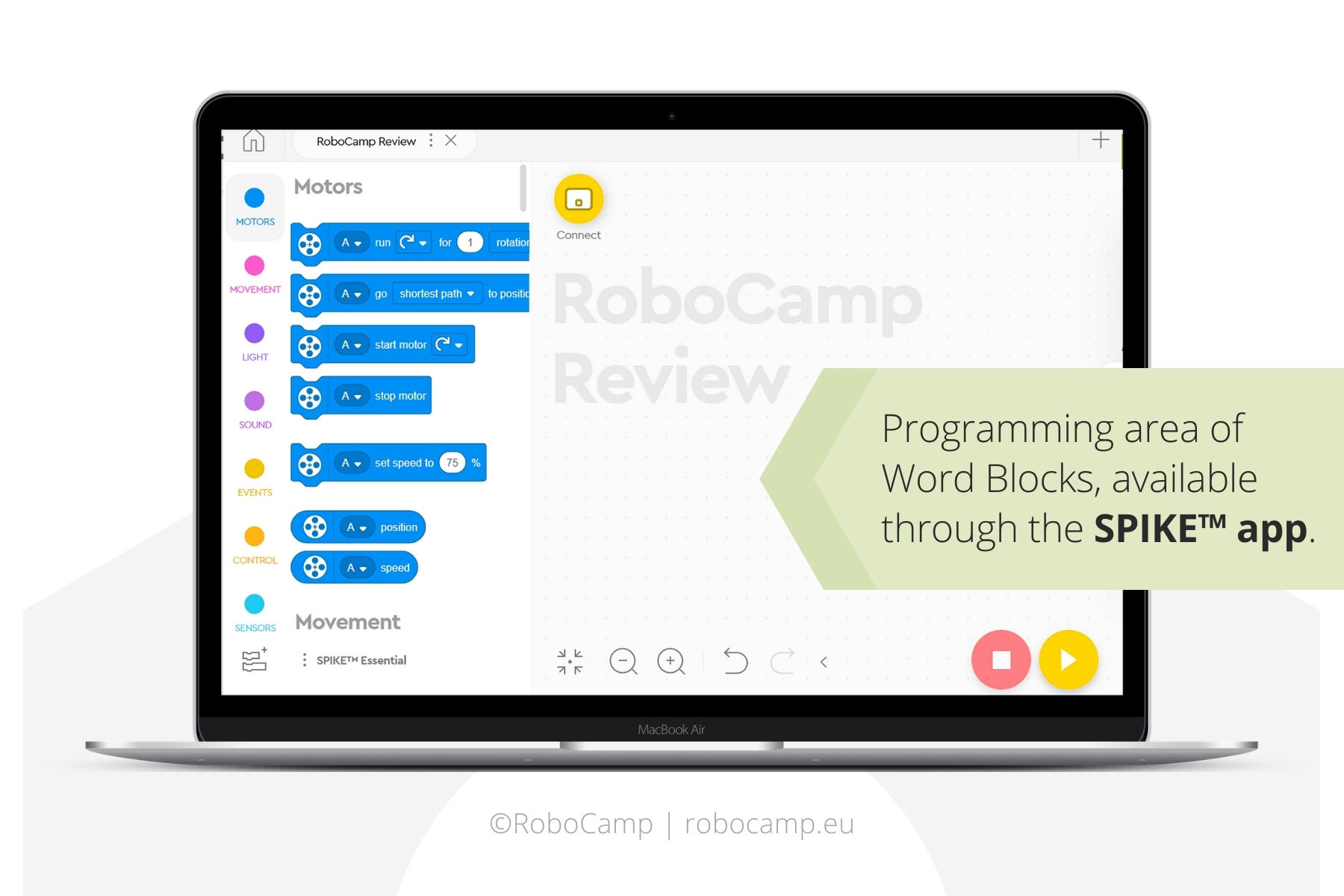
App interface is highly user-friendly. Finding all the options available to you is very intuitive, so you can just focus on teaching, or learning, instead of straining your brain cells wondering what is where and how to start a new project, which was an issue in EV3 Lab. Our team especially appreciates easy access to the hub preview directly in the programming area. Because it includes data on ports and sensor readings, it’s informative and very helpful when coding.
One app contains three programming languages: Icon Blocks, Word Blocks and Python. However, SPIKE Essential cannot be programmed in Python, so we’ll save reviewing it for another time. The first two are block-based programming languages, good for learning how to code (with some limitations, more about it below). With Icon Blocks, your students don’t even have to know how to read! But knowing numbers from 0 to 10 is a must.
In addition, the app gives you access to teacher resources made by LEGO. Every unit includes several lessons with a short narrative featuring the minifigures, building instructions and unexplained programming. If you decide to give them a try, remember that you should additionally explain the program to your students, because they may not figure it out on their own. Also, be mindful of the blocks palette; in lesson mode, it is restricted and contains only essential blocks.
On the flip side, because the app is quite extensive, it takes up a lot of space. Make sure you have 3GB free disc space and 4GB RAM before you fire it up.
System Requirements¶
Windows
- 1.5 GHz Intel® Core i3 processor or better
- 4 GB RAM
- 3 GB free disc space
- Bluetooth 4.0 or above
- Windows 10 (64-bit), ver. 1803 or newer
macOS
- 1.5 GHz Intel® Core Duo processor or equivalent or better
- 4 GB RAM
- 2 GB free disc space
- Bluetooth 4.0 or above
- macOS Mojave 10.14 or newer
iOS (tablets only) (click to open)
- iPad Air 2 and iPad Mini 4 or newer
- iOS 13 or newer
Android (tablets only) (click to open)
- 8” display or larger
- 3 GB RAM
- 3 GB free disc space
- Bluetooth 4.0 or above
- Android 7.0 or newer
Chrome OS (click to open)
- 1.40 GHz Intel® Celeron® 2955U dual-core processor or equivalent or better
- 4 GB RAM
- 3 GB free disc space
- Bluetooth 4.0 or above
- Chromebook running Android 7.0 or newer
- Google Play Store access required
Icon Blocks¶
Icon Blocks is the simplest coding language of the two available for SPIKE Essential. It is block-based, colorful, clearly inspired by Scratch Junior, and you can skillfully use it even before mastering the ability to read.
It is a good way for kids to start coding, to discover that with just a few commands entered on a computer, they can influence the physical world around them.
Commands are represented by various icons, thus the name, which symbolize the expected outcome of a coding block. To create a program, you simply take a block from the scrollable palette at the bottom, drop it in the programming area, then attach another block to create a logical sequence of actions. To run a program, you need to connect the hub via Bluetooth or cable, then simply press Play.
On the surface, this language looks perfect. But the devil is in the details.
![]()
Motor blocks, for example, give you a nice new option to control the range of motion every 90°, which is also presented in a graphic form, easy to understand for children. However, you must always specify for how long the motor is supposed to operate. Controlling the speed is now restricted to only 4 options: 15%, 40%, 70%, or 100%. What’s more, you cannot select the port of the motor, so you cannot control two motors separately. Finally, watch out for the Stop Motor bug; this block does not always work.
Programming loops can be nested, ad infinitum too, which may sometimes be useful. However, you cannot create a loop with an exit condition, only with a number of repetitions.
Conditional statements are a conundrum. Although the palette includes Send/Receive Message blocks, using them for conditional statements is out of the question. Instead, their purpose seems to be activating several scripts at once, or introducing a random element into the program, which is not as useful, or educational.
But the biggest disappointment is a highly limited use of sensor readings. If you take a closer look at the blocks palette, you will notice that each time you want to use a sensor reading in a program, you have to activate a new script. There is simply no other way, because only start blocks allow sensors to take a reading and send its value to the program.
In other words, any marginally interactive program requires multithreading. This is problematic for three main reasons.
- Multithreading is not exactly an easy-peasy concept for primary school kids, especially if they previously had little to no chance to create programs with just one thread.
- Introducing multithreading so early will probably make students focus on events more, but it may also prompt them to disregard logical sequence, which is absolutely crucial in programming.
- Let’s not forget that Icon Blocks are an introduction to Word Blocks. In Word Blocks, starting a new script every time a new tiny event happens would be plain madness.
Therefore, some of the first steps that kids take by coding in Icon Blocks will not only be more challenging, they will also be in the wrong direction.
Nonetheless, many of these issues could be resolved by adding a few more programming blocks to the app, which we hope will happen soon. Otherwise, we suggest moving on to Word Blocks as soon as possible.
Word Blocks¶
Without a doubt, Word Blocks is the better programming language for SPIKE Essential. We are playing favorites here, and for good reasons.
Word Blocks is based on the contemporary education classic, Scratch, so the same age recommendations apply: it works best for 8 to 16 year olds. Colorful blocks with text and parameters are stacked together to create programs that will animate robots and other constructions assembled from LEGO elements.
Individual code blocks have different shapes that suggest their place in the program, just like in Scratch. Understanding them is key in creating programs.
Every script should start with a hat block connected to at least one stack block. Cap blocks end a script. C-blocks represent a loop, or a condition, and have a gap in the middle for additional stack blocks. The last two types must be combined with other blocks to function in a script: hexagonal Boolean blocks contain a condition that can be true or false; rounded reporter blocks hold numeric or text values.
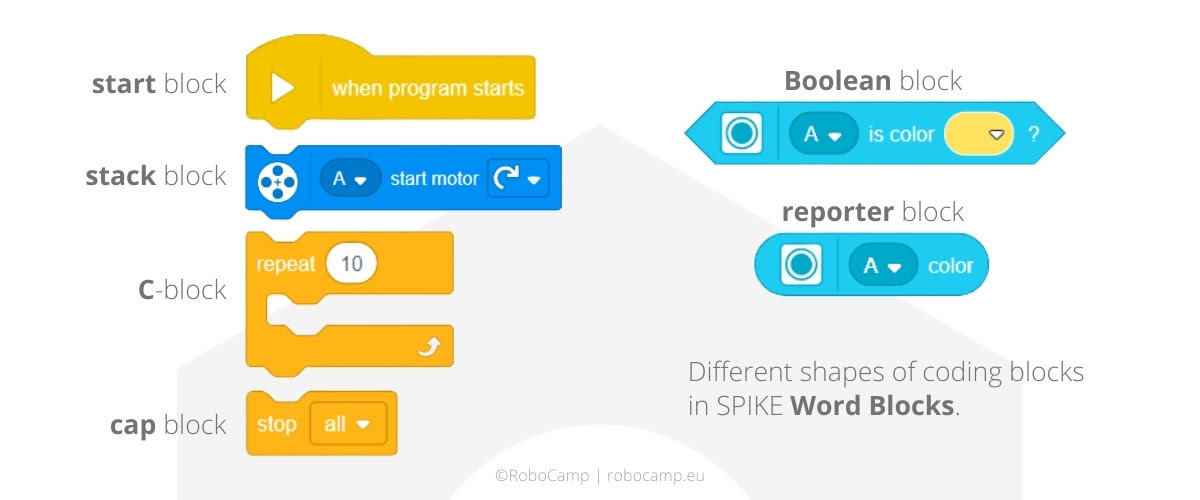
When you create a new project in Word Blocks, you get access to all the default programming blocks, divided into familiar categories: Motors (one motor control), Movement (two motors control), Light (Light Matrix control), Sound, Events, Control, Sensors, Operators, Variables. There is also My Blocks, where you can create a new function from the code blocks available.
You can easily expand this selection by enabling optional categories: Weather Manager, More Motors, More Movement, More Sensors, Music, Line Graph, Bar Graph, or Display. These extensions widen programming possibilities, for example using power instead of speed, raw colors, relative position, etc.; or provide additional visual options, like alternative ways to present data, or to display an image on the screen.
Two of these extensions are especially interesting in the context of cross-curricular STEAM lessons. Weather Manager uses internet connection to get the weather data from the Norwegian Meteorological Institute and allows you to pick the location anywhere in the world (for locations go to www.yr.no/en). Music extension, with 21 different instruments and 18 kinds of drums, is a must-have for young composers.
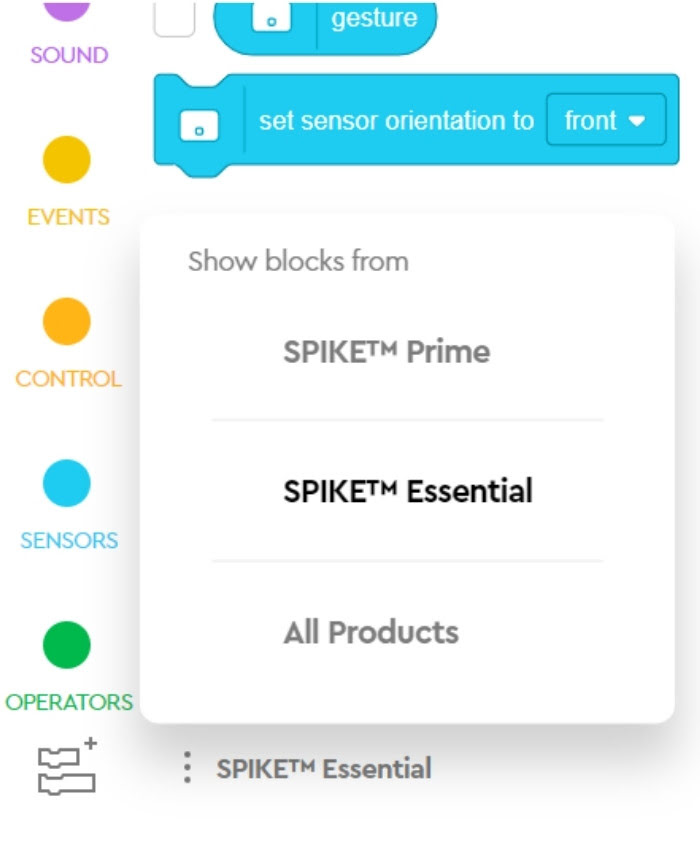
ProTip: If you have selected SPIKE Essential upon launching the app, your blocks palette will show you only blocks that are compatible with this set. However, you can easily change this setting at the project level to SPIKE Prime, or All Products. Very handy, especially if you like to see all the possibilities.
With Word Blocks, you can make most of the motors and sensors in the set. You can pick their port, exact speed and position, decide in which direction the motors should rotate and for how long. You can use sensor readings without having to start a new script. You can easily program the motor to take the shortest path to the position you want, a helpful command to quickly reset the starting position of a robot. And so much more!
Possibilities of Word Blocks are wide, largely thanks to the Variables, Operators and Control categories (almost non-existent in Icon Blocks). Your students will be able to create complex and interesting programs with conditional statements, various kinds of loops, mathematical operations, variables and lists. In other words, this environment allows kids to make the most of programming robots and discover key coding concepts in a user-friendly environment.
Together with the polished interface of the app, Word Blocks is a great tool for learning and discovering the potential of programming.
Are there any disadvantages of Word Blocks? Not in the context of regular school lessons.
Comparison of SPIKE Essential and WeDo 2.0¶
Ever since the launch of SPIKE™ Essential, the most common question we hear from teachers is this:
Should I get SPIKE Essential now? Or should I stick to WeDo 2.0?
If you have enough WeDo 2.0 sets for your students and keep some replacement parts in the back, hold your horses and keep on teaching with what you have. Good old WeDo 2.0 sets are sturdy, still supported, and have plenty of building and programming potential. Don’t throw them away.
However, if you do not meet those requirements, but need robotic kits for early primary school education (i.e. SPIKE™ Prime is too advanced for your students), get SPIKE Essential.
Now, let’s look into the potential of each set.
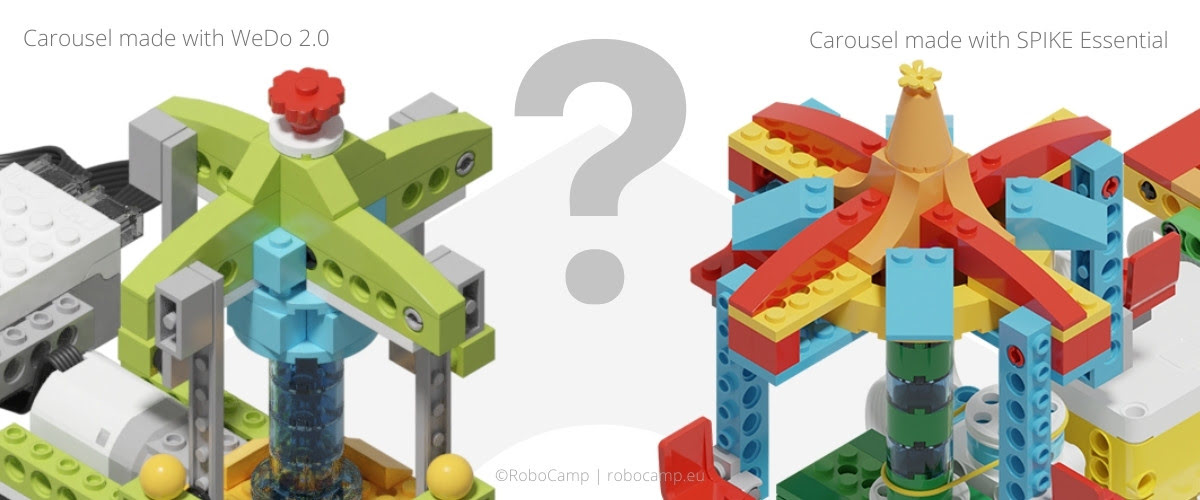
In terms of building possibilities, as well as simplicity of connecting elements together and creating various mechanisms from few parts, WeDo 2.0 comes out on top. Its selection of parts is versatile and well thought-out for kids ages 7-10. SPIKE Essential has no gears, which means fewer interesting mechanisms, and includes a lot of Technic bricks, which makes building more difficult for children.
Electronics in WeDo 2.0 cover all the key aspects of motion: one motor, one distance sensor, one tilt sensor. SPIKE Essential seems to be more concerned with color: two motors, one color sensor, one light matrix, and a tilt sensor hidden inside the hub. The latter has more electronics, but they don’t necessarily widen its educational potential. Actually, this selection slightly limits the possibilities of creating an interactive robot.
Hubs of either set are similar in size, have only two ports each, but WeDo 2.0 hub can be powered with cheap AA batteries, unlike the newer Intelligent Hub.
As for programming, in the beginning WeDo 2.0 could be programmed in only one, simple language with icons; later on, an extension for Scratch 3 was created - certainly useful, but not perfect. SPIKE Essential can be programmed in two languages, both described above. In this category, the newer kit should win hands down, except… The programming language designed for the youngest users, Icon Blocks, is not that great at the moment. Since SPIKE Essential is targeted at young kids entering primary school, this is a big flaw. Fortunately, it is fixable. We are hopeful that LEGO Education will soon update their app and add several much needed coding blocks.
One big advantage of SPIKE Essential is that it creates a smooth transition to the next level of robotics and programming with SPIKE Prime. When learning, gradual progress is always better. Previously, going from happy-go-lucky WeDo 2.0 to serious MINDSTORMS EV3 could cause a major shock, which discouraged some students.
Finally, the price. SPIKE Essential ($274.95) is more expensive than WeDo 2.0, unless you count a dozen or so WeDo 2.0 kits left on the second hand market, which are now reaching astronomical prices.
The hard truth is that WeDo 2.0 is not coming back. The good news is that SPIKE Essential is not a bad set overall. Even if it is not as great as WeDo 2.0, it sill gives students a chance to create and program their own robots - there’s no beating that. There are some issues to work out, but this product was just launched, so perhaps an update with an improved version of Icon Blocks is just around the corner.
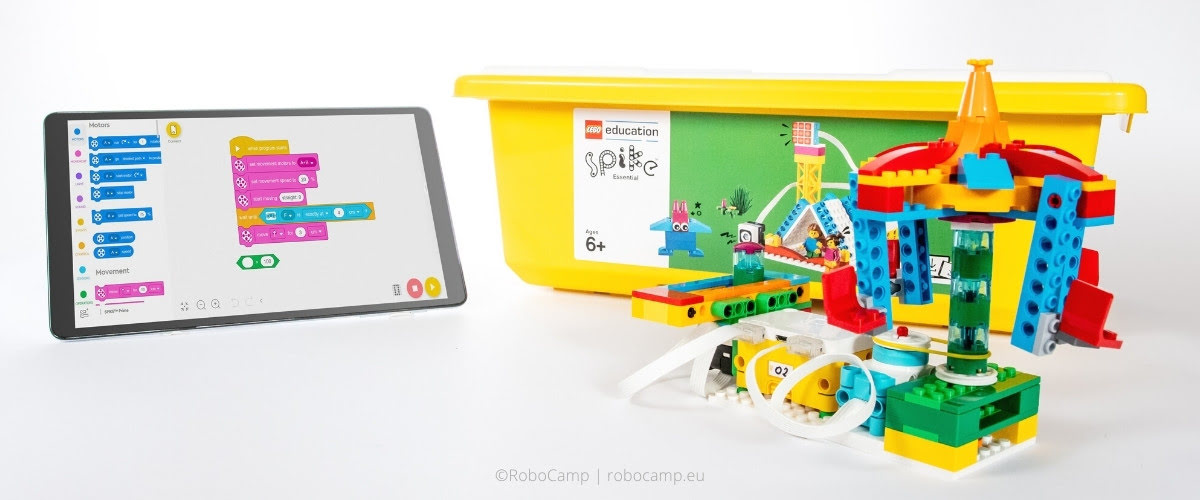
Conclusions¶
SPIKE Essential is a box of contradictions. While its numerous qualities aid and facilitate school use, others undermine this outcome.
Building constructions should be faster now, thanks to thoughtfully including special bricks that speed up this process. That’s a very important feature for standard school lessons. However, finding the right brick takes more time due to color-coded trays; creating an interesting mechanism stretches this time further, because kids have no access to gears.
Lowering the age bracket to 6 years old should mean that joining individual parts is easier for small hands. Including so many Technic elements contradicts this.
More electronics should translate into more programmable abilities of a robot, or expanded interactivity of a construction. However, there is no distance sensor and the hub has only two ports, so these possibilities are still very limited.
Programming app has a user-friendly interface, is compatible with the entire SPIKE™ series, and features 3 programming languages, which should ensure easy introduction to coding and maintaining smooth progress through several levels of programming education. However, the restricted use and educational issues of the easiest language for young learners, Icon Blocks, manages to foil this perfect plan.
Most of these problems are easy to solve with extra parts, or coding blocks. Almost as if LEGO Education managed to create an excellent robotics set for early primary school education, but then decided to take out some key elements.
Can you purchase additional sets to fill these holes? Yes. But it’s not a universal solution. It requires more money, more space, and exceptional organizational skills to handle several large boxes of parts on student desks. Not every school is lucky to have all three. This is why instead of trying to fix these flaws at all costs, it might be better to stay within the bounds and work with what we have.
After all, even if SPIKE Essential performs slightly worse than the very best robotics sets for education, this means it’s still very good. One can complain about its weak spots, but refusing to see the merits of this set would be ignorant.
The most important advantages of SPIKE Essential are: high quality of bricks and electronics, user-friendly programming, compatibility with SPIKE Prime, real possibility to conduct lessons only 45 minutes long, and interesting elements to help stimulate students’ interest. In other words, the parts do not break, the app is easy to use, continuing the education is straightforward, the projects can be completed within standard lesson timeframe, and students will be interested - if not by the project, they will focus their attention on the minifigures.
All of the above are meaningful especially in the context of school education, because they actually help to conduct trouble-free lessons.
Of course, the flaws are still there. If you are worried about their impact on your lessons, stick with RoboCamp. Our lesson plans bypass these weak spots and make most of the building and programming possibilities created by this set. Have fun!



